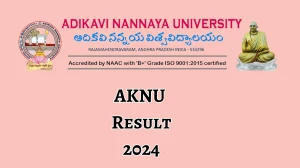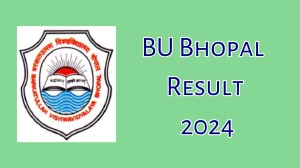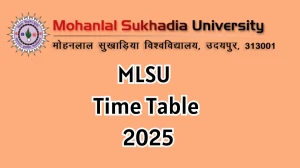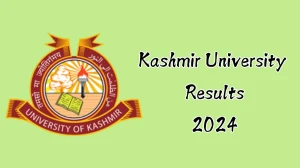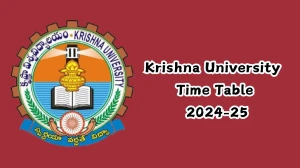- Rojgarlive »
- Education »
- TS 2nd Year Inter Chemistry Syllabus 2024-25 at tgbie.cgg.gov.in PDF Download Here
TS 2nd Year Inter Chemistry Syllabus 2024-25 at tgbie.cgg.gov.in PDF Download Here
by Keerthika
Updated Sep 18, 2024
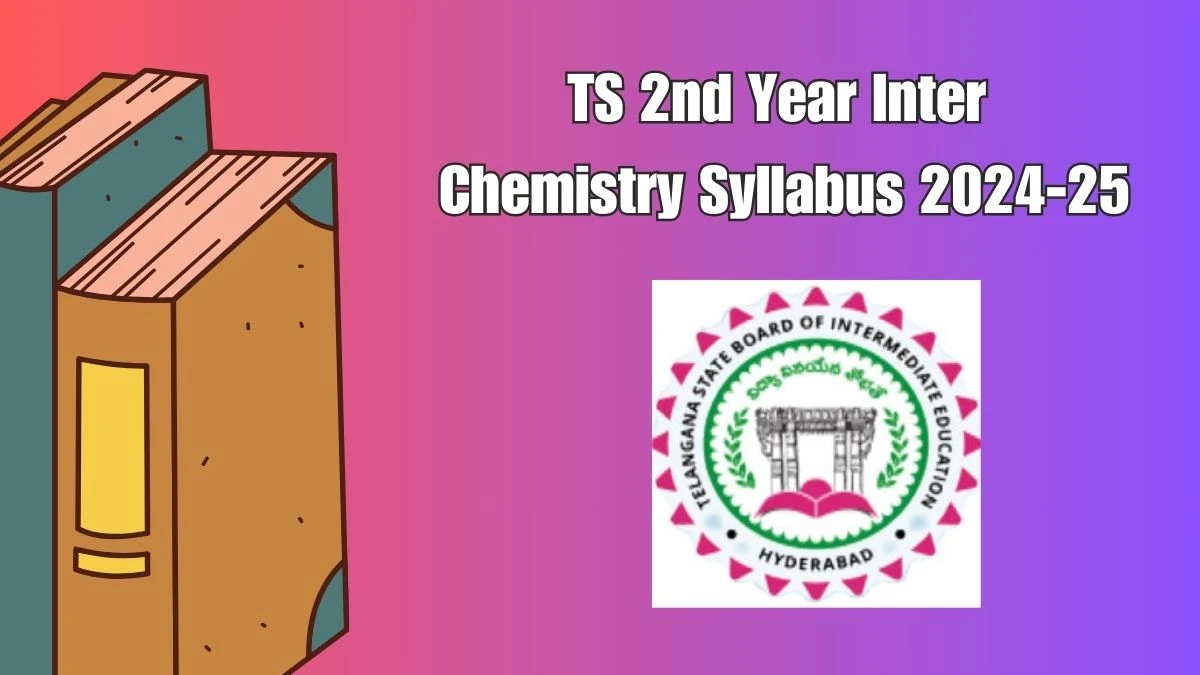
TS 2nd Year Inter Chemistry Syllabus 2024-25 @ tgbie.cgg.gov.in
The Telangana State Board of Intermediate Education (TS Board) Class 12 Chemistry syllabus for 2024-25 is provided here to help students understand the topics they need to prepare for the 2025 board exams. The syllabus covers essential topics such as states of matter, solutions, chemical kinetics, electrochemistry, and more. These subjects are crucial for students' future academic growth, as higher education builds on these foundational concepts. Read this article to view and download the TS 2nd year Chemistry syllabus for 2024-25.
Check - TS 2nd Year Inter Chemistry Syllabus 2024-25
TS 2nd Year Chemistry Syllabus 2024-25
The Telangana Board Class 12 Chemistry curriculum for the 2025 board examination is given here along with the free PDF download at the link attached after this information.
|
1. SOLID STATE SOLID STATE SOLID STATE 1.1 General Characteristics of Solid State 1.2 Amorphous and Crystalline Solids 1.3 Classification of Crystalline Solids 1.4 Probing the structure of solids: X-ray crystallography 1.5 Crystal Lattices and Unit Cells 1.6 Number of Atoms in a Unit Cell 1.7 Close Packed Structures 1.8 Packing Efficiency 1.9 Calculations Involving Unit Cell Dimensions 1.10 Imperfections in Solids 1.11 Electrical Properties 1.12 Magnetic Properties |
|
2. SOLUTIONS SOLUTIONS SOLUTIONS 2.1 Types of Solutions 2.2 Expressing Concentration of Solutions 2.3 Solubility 2.4 Vapour Pressure of Liquid Solutions 2.5 Ideal and Non-ideal Solution 2.6 Colligative Properties and Determination of Molar Mass 2.7 Abnormal Molar Masses |
|
3. ELECTROCHEMISTRY AND CHEMICAL KINETICS 3.1 Electrochemical Cells 3.2 Galvanic Cells 3.3 Nernst Equation 3.4 Conductance of Electrolytic Solutions 3.5 Electrolytic Cells and Electrolysis 3.6 Batteries 3.7 Fuel Cells 3.8 Corrosion CHEMICAL KINETICS 3.9 Rate of a Chemical Reaction 3.10 Factors Influencing Rate of a Reaction 3.11 Integrated Rate Equations 3.12 Pseudo First Order Reaction 3.13 Temperature Dependence of the Rate of a Reaction 3.14 Collision Theory of Chemical Reaction Rates PRACTICALS: A.Surface Chemistry (a) Preparation of one lyophilic and onelyophobsol (b) Study of the role of emulsifying agents in stabilizing the emulsions of different oils |
|
4. SURFACE CHEMISTRY 4.1 Adsorption 4.2 Catalysis 4.3 Colloids 4.4 Classification of Colloids 4.5 Emulsions 4.6 Colloids Around Us |
|
5. GENERAL PRINCIPLES OF GENERAL PRINCIPLES OF GENERAL PRINCIPLES OF METALLURGY METALLURGY METALLURGY 5.1 Occurance of Metals 5.2 Concentration of Ores 5.3 Extraction of Crude Metal from Concentrated Ore 5.4 Thermodynamic Principles of Metallurgy 5.5 Electrochemical Principles of Metallurgy 5.6 Oxidation and Reduction 5.7 Refining of Crude Metal 5.8 Uses of Aluminium, Copper, Zinc and Iron PRACTICALS: B. Chemical Kinetics C.Solutions |
|
6. p-BLOCK ELEMENTS GROUP BLOCK ELEMENTS GROUP BLOCK ELEMENTS GROUP-15 ELEMENTS 15 ELEMENTS 6.1 Introduction 6.2 Dinitrogen 6.3 Ammonia 6.4 Oxides of nitrogen 6.5 Nitric acid 6.6 Phosphorous-allotropic forms 6.7 Phosphine 6.8 Phosphorous halides 6.9 Oxoacids of phosphorous GROUP-16 ELEMENTS 16 ELEMENTS 16 ELEMENTS 6.10 Introduction 6.11 Dioxygen 6.12 Simple Oxides 6.13 Ozone 6.14 Sulphur-Allotropic forms 6.15 Sulphur dioxide 6.16 Oxoacids of Sulphur 6.17 Sulphuric Acid GROUP-17 ELEMENTS 17 ELEMENTS 17 ELEMENTS 6.18 Introduction 6.19 Chlorine 6.20 Hydrogen Chloride 6.21 Oxoacids of Halogens 6.22 Interhalogen Compounds GROUP-18 ELEMENTS 18 ELEMENTS 18 ELEMENTS 6.23 Introduction- Occurance, Electronic configuration Ionisation Enthalpy,Atomic radii, Electron Gain Enthalpy Physical and Chemical properties PRACTICALS : D. Electrochemistry E. Chromatography F. Preparation of Inorganic Compounds |
|
7. d AND f BLOCK ELEMENTS & COORDINATION COMPOUND 7.1 Position in the Periodic Table 7.2 Electronic Configuration 7.3 General Properties of Transition Elements (dBlock) 7.4 Some Important Compounds of Transition Elements 7.5 Inner Transition Elements(f-Block) 7.6 Actinoids 7.7 Some Applications of d and f Block Elements 7.8 Werner’s Theory of Coordination Compounds 7.9 Definitions of Some Terms used in Coordination Compounds 7.10 Nomenclature of Coordination Compounds 7.11 Isomerism in Coordination Compounds 7.12 Bonding in Coordination Compounds 7.13 Bonding in Metal Carbonyls 7.14 Stability of Coordination Compounds 7.15 Importance and Applications of Coordination Compounds |
|
8. POLYMERS 8.1 Classification of Polymers 8.2 Types of Polymerization Reactions 8.3 Molecular Mass of Polymers 8.4 Biodegradable Polymers 8.5 Polymers of Commercial Importance |
|
9. BIOMOLECULES 9.1 Carbohydrates 9.2 Proteins 9.3 Enzymes 9.4 Vitamins 9.5. Nucleic acids 9.6 Hormones |
|
10. CHEMISTRY IN EVERYDAY LIFE 10.1 Drugs and their Classification 10.2 Drug-Target Interaction 10.3 Therapeutic Action of Different Classes of Drugs 10.4 Chemicals in Food 10.5 Cleansing Agents PRACTICALS: G. Preparation of Organic Compounds H. Tests for the functional groups present in organic compounds I. Characteristic tests of carbohydrates, fats and Proteins |
|
11. HALO ALKANES AND HALOARENES 11.1 Classification 11.2 Nature of C-X bond 11.3 Methods of Preparation 11.4 Physical Properties 11.5 Chemical Reactions 11.6 Polyhalogen Compounds |
|
12. ORGANIC COMPOUNDS CONTAINING C, H AND O (Alcohols, Phenols, Ethers, Aldehydes, Ketones and Carboxylic acids) 12.1 Classification -Alcohols, Phenols and Ethers 12.2 Nomenclature- Alcohols, Phenols and Ethers 12.3 Structures of Hydroxy and Ether Functional Groups 12.4 Alcohols and Phenols 12.5 Physical Propertics 12.6 Chemical Reactions 12.7 Some Commercially Important Alcohols 12.8 Ethers |
|
Aldehydes and Ketones 12.9 Nomenclature and Structure of Carbonyl Group 12.10 Preparation of Aldehydes and ketones. 12.11 Physical Properties 12.12 Chemical Reactions 12.13 Uses of Aldehydes and Ketones PRACTICALS : J Determination of concentration/molarity of KMnO4 solution by titrating it against a standard solution of: (i) Oxalic acid, (ii) Ferrous ammonium sulphate |
|
Carboxylic Acids Carboxylic Acids 12.14 Nomenclature and Structure of Carboxyl Group 12.15 Methods of Preparation ofCarboxylic Acids 12.16 Physical Properties 12.17 Chemical Reactions 12.18 Uses of Carboxylic Acids |
|
13. ORGANIC COMPOUNDS CONTAINING NITROGEN Amines 13.1 Structure of Amines 13.2 Classification 13.3 Nomenclature 13.4 Preparation of Amines 13.5 Physical Properties 13.6 Chemical Reactions Diazonium salts 13.7 Methods of Preparation of Diazonium Salts 13.8 Physical Properties 13.9 Chemical Reactions 13.10 Importance of Diazonium Salts in Synthesis of Aromatic Compounds Cyanides and Isocyanides 13.11 Structure of cyanides and isocyanides 13.12 Preparation PREPARATION OFR PRE-FINAL EXAMINATIONS EXAMINATIONS EXAMINATIONS PRACTICALS : K. Qualitative analysis Determination of one cation and one anion in a given salt containing anions and cations studied in I year (Salts : 1 to 12) |
TS 2nd Year Inter Chemistry Syllabus 2024-25? -FAQ
The TS 2nd year Chemistry syllabus includes topics like states of matter, solutions, chemical kinetics, electrochemistry, surface chemistry, and more.
You can download the syllabus from the official Telangana State Board of Intermediate Education website or refer to this article for a direct link.
